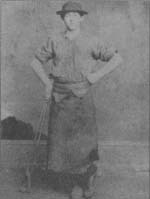 Historians believe that the Egyptians were the first people to work with small amounts of iron, some five or six thousand years ago. The metal they used was apparently extracted from meteorites. Evidence of what is believed to be the first example of iron mining and smelting points to the ancient Hittite culture in what is now Turkey. Because iron was a far superior material for the manufacture of weapons and tools than any other known metal, its production was a closely guarded secret. However, the basic technique was simple, and the use of iron gradually spread. As useful as it was compared to other materials, iron had disadvantages. The quality of the tools made from it was highly variable, depending on the region from which the iron ore was taken and the method used to extract the iron. The chemical nature of the changes taking place during the extraction were not understood; in particular, the importance of carbon to the metal’s hardness. Practices varied widely in different parts of the world. There is evidence, for example, that the Chinese were able to melt and cast iron implements very early, and that the Japanese produced amazing results with steel in small amounts, as evidenced by heirloom swords dating back centuries. Similar breakthroughs were made in the Middle East and India, but the processes never emerged into the rest of the world. For centuries the Europeans lacked methods for heating iron to the melting point at all. To produce iron, they slowly burned iron ore with wood in a clay-lined oven. The iron separated from the surrounding rock but never quite melted. Instead, it formed a crusty slag which was removed by hammering. This repeated heating and hammering process mixed oxygen with the iron oxide to produce iron, and removed the carbon from the metal. The result was nearly pure iron, easily shaped with hammers and tongs but too soft to take and keep a good edge. Because the metal was shaped, or wrought, by hammering, it came to be called wrought iron.
Historians believe that the Egyptians were the first people to work with small amounts of iron, some five or six thousand years ago. The metal they used was apparently extracted from meteorites. Evidence of what is believed to be the first example of iron mining and smelting points to the ancient Hittite culture in what is now Turkey. Because iron was a far superior material for the manufacture of weapons and tools than any other known metal, its production was a closely guarded secret. However, the basic technique was simple, and the use of iron gradually spread. As useful as it was compared to other materials, iron had disadvantages. The quality of the tools made from it was highly variable, depending on the region from which the iron ore was taken and the method used to extract the iron. The chemical nature of the changes taking place during the extraction were not understood; in particular, the importance of carbon to the metal’s hardness. Practices varied widely in different parts of the world. There is evidence, for example, that the Chinese were able to melt and cast iron implements very early, and that the Japanese produced amazing results with steel in small amounts, as evidenced by heirloom swords dating back centuries. Similar breakthroughs were made in the Middle East and India, but the processes never emerged into the rest of the world. For centuries the Europeans lacked methods for heating iron to the melting point at all. To produce iron, they slowly burned iron ore with wood in a clay-lined oven. The iron separated from the surrounding rock but never quite melted. Instead, it formed a crusty slag which was removed by hammering. This repeated heating and hammering process mixed oxygen with the iron oxide to produce iron, and removed the carbon from the metal. The result was nearly pure iron, easily shaped with hammers and tongs but too soft to take and keep a good edge. Because the metal was shaped, or wrought, by hammering, it came to be called wrought iron.
Raw Materials
The raw materials used to produce pig iron in a blast furnace are iron ore, coke, sinter, and limestone. Iron ores are mainly iron oxides and include magnetite, hematite, limonite, and many other rocks. The iron content of these ores ranges from 70% down to 20% or less. Coke is a substance made by heating coal until it becomes almost pure carbon. Sinter is made of lesser grade, finely divided iron ore which, is roasted with coke and lime to remove a large amount of the impurities in the ore. Limestone occurs naturally and is a source of calcium carbonate.
Other metals are sometimes mixed with iron in the production of various forms of steel, such as chromium, nickel, manganese, molybdenum, and tungsten.
The Ore Extraction and Refining Process
Before iron ore can be used in a blast furnace, it must be extracted from the ground and partially refined to remove most of the impurities.

Historically, iron was produced by the hot-blast method, or later, the anthracite furnace. Either way, the fundamental activity in iron making involved a worker stirring small batches of pig iron and cinder until the iron separated from the slag. Called “puddling,” this was highly skilled work, but was also hot, strenuous, and dangerous. It required a lot of experience as well as a hearty constitution. Puddlers were proud, independent, and highly paid









